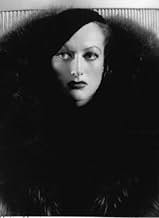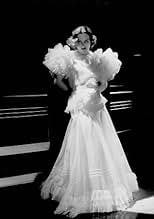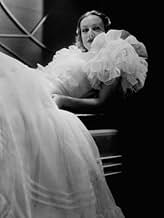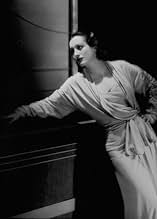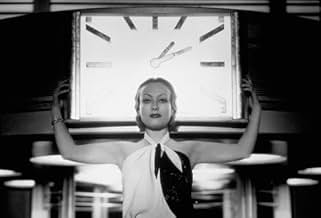Agrega una trama en tu idiomaA socialite begins a shipboard romance with a wealthy man, but is blackmailed by a former lover.A socialite begins a shipboard romance with a wealthy man, but is blackmailed by a former lover.A socialite begins a shipboard romance with a wealthy man, but is blackmailed by a former lover.
- Dirección
- Guionistas
- Elenco
- Premios
- 4 premios ganados en total
Sidney Bracey
- Waiter
- (sin créditos)
Edward LeSaint
- Dr. Sanders
- (sin créditos)
Edgar Norton
- Darrow's Butler
- (sin créditos)
Lee Phelps
- Dennis, Darrow's Chauffeur
- (sin créditos)
C. Montague Shaw
- Ship's Officer at Christmas Party
- (sin créditos)
Harry Stubbs
- Ship's Steward
- (sin créditos)
Charles Williams
- Reporter
- (sin créditos)
- Dirección
- Guionistas
- Todo el elenco y el equipo
- Producción, taquilla y más en IMDbPro
Opiniones destacadas
Letty Lynton is unfortunately barred from being formally released due to a lawsuit, a shame because it is a good early Crawford film. The story revolves around Letty Lynton (Joan Crawford), a woman whose past with Emile (Nils Asther) makes her a less than desirable woman. She falls in love with Jerry (Robert Montgomery) who loves her in return and intends to make her his wife. But he doesn't know of her past and that Emile has come to claim her.
Crawford looked best in these early talkies with fabulous wardrobes by Adrian and a gorgeous face. As an actress, she is natural and enthusiastic. She has chemistry with both the seductive Asther and the charismatic Montgomery, making for a more interesting story.
There are several funny scenes in the film as well as plenty of drama, making it accessible by wider audiences, that is, if one can find a copy.
Crawford looked best in these early talkies with fabulous wardrobes by Adrian and a gorgeous face. As an actress, she is natural and enthusiastic. She has chemistry with both the seductive Asther and the charismatic Montgomery, making for a more interesting story.
There are several funny scenes in the film as well as plenty of drama, making it accessible by wider audiences, that is, if one can find a copy.
In Letty Lynton, Joan Crawford gets involved in a dangerous gangster, Nils Asther while in South America. Then, on the boat sailing home, she falls in love with clean, noble Robert Montgomery. They get engaged but Joan lives in constant fear that someone from her past will surface and Bob won't want her anymore if he learns she's had other men in her life. It's a theme that was common in many other 1930s films but it doesn't carry over in modern audiences. In this movie, it's supposed to be believable that Robert Montgomery thinks a woman who fell head over heels for him while on a cruise ship is respectable and completely innocent.
Because of the dated plot, which was carried out far more effectively in other films, this movie didn't make it to my favorites list. I'm not really a Joan Crawford fan anyway, and it's hard to believe anyone would be stupid enough to think she was innocent. If someone was that stupid, then chances are if he heard a rumor or personal testament to the contrary, he still wouldn't believe it.
There's a parallel from Letty Lynton to the same year's Faithless, in the scene where the heroine feels helpless as the villain carries her to the bedroom. Both Joan Crawford and Tallulah Bankhead laugh hysterically in their sorrow, but where Tallulah's outburst feels genuine, Joan's feels like it's the tenth take and she's trying to laugh loud enough for the entire studio to hear her. This movie was very obviously made in 1932 and could even be imagined as a silent movie. If you are a stickler for very good quality films, look elsewhere tonight.
Because of the dated plot, which was carried out far more effectively in other films, this movie didn't make it to my favorites list. I'm not really a Joan Crawford fan anyway, and it's hard to believe anyone would be stupid enough to think she was innocent. If someone was that stupid, then chances are if he heard a rumor or personal testament to the contrary, he still wouldn't believe it.
There's a parallel from Letty Lynton to the same year's Faithless, in the scene where the heroine feels helpless as the villain carries her to the bedroom. Both Joan Crawford and Tallulah Bankhead laugh hysterically in their sorrow, but where Tallulah's outburst feels genuine, Joan's feels like it's the tenth take and she's trying to laugh loud enough for the entire studio to hear her. This movie was very obviously made in 1932 and could even be imagined as a silent movie. If you are a stickler for very good quality films, look elsewhere tonight.
So many films of great movie stars are out of circulation for one reason of another. LETTY LYTTON is one of them. I have never seen it, although (from the sound of it it sounds interesting). I can though illuminate something of the background.
Marie Belloc Lowndes is recalled today for one novel (from a short story) entitled "THE LODGER". She was fascinated by crime and wrote books based on famous cases (like a younger contemporary, "Joseph Shearing"). THE LODGER was about the Jack the Ripper murders. Other novels of hers were turned into movies. THE STORY OF IVY became a film with Joan Fontaine as an unscrupulous poisoner (of her husband) - supposedly based on the Maybrick Murder Case of 1889.
LETTY LYTTON was based on the Madeleine Smith poisoning case of 1857 in Glasgow, Scotland. Madeleine was supposed to marry a Mr. William Minnoch, in a marriage approved by her very strict father (a leading architect). But she had been having very close relations with an Emile L'Angelier (foreign sounding for Scotland, but L'Angelier was from the Channel Islands of Great Britain). L'Angelier may have loved Madeleine, but he was also socially attracted to her position in Glasgow. He would not let her drop the relationship. Several times he visited her, and came home ill. The last time he died. Subsequently arsenic was found on his corpse. Love letters written by Madeleine led to her arrest. She was tried, but the jury (despite good reason) was not willing to find her guilty. They did not acquit either. Instead, she was found "Not Proven", which is a verdict on Scotland has. Madeleine eventually married an artist, George Wardle, until their divorce in the 1880s. She became a socialist (one of her friends in London was George Bernard Shaw). She married a second time, emigrated to America, and died in New York City (in the Bronx) in 1926 when in her nineties. She is buried there.
Certainly, in her later years, she did not have the wonderful wardrobe that was Ms Crawford's courtesy of MGM, but she had a reasonably quiet life. She fought a motion picture studio in the 1920s which wanted to make him a film about her career (it wasn't made). A woman of spirit (even if you do not think her innocent of murder). She did not know that LETTY LYTTON would appear in a film suggested by her story within a decade, nor that (in 1950) David Lean would make the definitive film about the case: MADELEINE.
Marie Belloc Lowndes is recalled today for one novel (from a short story) entitled "THE LODGER". She was fascinated by crime and wrote books based on famous cases (like a younger contemporary, "Joseph Shearing"). THE LODGER was about the Jack the Ripper murders. Other novels of hers were turned into movies. THE STORY OF IVY became a film with Joan Fontaine as an unscrupulous poisoner (of her husband) - supposedly based on the Maybrick Murder Case of 1889.
LETTY LYTTON was based on the Madeleine Smith poisoning case of 1857 in Glasgow, Scotland. Madeleine was supposed to marry a Mr. William Minnoch, in a marriage approved by her very strict father (a leading architect). But she had been having very close relations with an Emile L'Angelier (foreign sounding for Scotland, but L'Angelier was from the Channel Islands of Great Britain). L'Angelier may have loved Madeleine, but he was also socially attracted to her position in Glasgow. He would not let her drop the relationship. Several times he visited her, and came home ill. The last time he died. Subsequently arsenic was found on his corpse. Love letters written by Madeleine led to her arrest. She was tried, but the jury (despite good reason) was not willing to find her guilty. They did not acquit either. Instead, she was found "Not Proven", which is a verdict on Scotland has. Madeleine eventually married an artist, George Wardle, until their divorce in the 1880s. She became a socialist (one of her friends in London was George Bernard Shaw). She married a second time, emigrated to America, and died in New York City (in the Bronx) in 1926 when in her nineties. She is buried there.
Certainly, in her later years, she did not have the wonderful wardrobe that was Ms Crawford's courtesy of MGM, but she had a reasonably quiet life. She fought a motion picture studio in the 1920s which wanted to make him a film about her career (it wasn't made). A woman of spirit (even if you do not think her innocent of murder). She did not know that LETTY LYTTON would appear in a film suggested by her story within a decade, nor that (in 1950) David Lean would make the definitive film about the case: MADELEINE.
The drop-dead gorgeous gown, (you all know, which one I'm talking about) that Joan Crawford wears in this film, is probably the best gown ever designed in Hollywood..... (really the greatest trend in hollywood history) Joan Crawford wears it with such class, and elegance...... Hollywood could never make such a film nowadays....... (everything has gone from tasteless, to trash) Now, about the movie itself...... I would say, that it's an above average movie, although nothing really outstanding about the story...... Evidently, the high fashion display outshine the movie itself....... (at times, I felt the movie was a fashion showcase)Nevertheless, Crawford & Montgomery, are the great team duo...... Crawford chic, and beautiful never looked lovelier, and Montgomery his usual handsome, dashing self....... Recommended for both Crawford & Montgomery fans.
This is one of those "mythic" films, the 1932 Joan Crawford vehicle not available anywhere, not even for TV broadcasting, because it's been in a legal tangle for decades and decades; the film in which Crawford wore one of the most famous outfits ever displayed on screen, a beautiful Adrian creation, a white evening dress which was copied in its time and sold to eager female fans in Department Stores along the United States.
In this glossy film, Crawford plays the title role, a rich and spoiled heiress, who's been living the "wild life" in Montevideo, the capital city of Uruguay with debonair man-of-the-world Emile Rénaul, played by Nils Asther only to regret it when clean-cut Jerry Darrow (Robert Montgomery) comes into her life.
This is a star-vehicle all the way, with Crawford being photographed in the most ravishing poses, positions, from the best angles; much care was put in the in the lighting and her make-up & wardrobe. Perhaps this is one of the films in which I've seen Crawford at her prettiest and sexiest, wearing a chain of exquisite, sophisticated Adrian designed evening dresses and suits, furs et al, all carefully designed to conceal her broad shoulders, which later became a trademark of hers. At this time she had not fully developed into the dramatic actress she later became, but in spite of some heavy melodramatics, her performance is good.
Her co-star Robert Montgomery has little to do in comparison but being well-bred and nice and he is good, as usual, at it. Nils Asther is the "heavy" here and being a Swedish, believably interprets an European, evil, magnate who doesn't want Letty let go; maybe his style of playing the continental lover (sometimes displaying heavy emoting) may seem somewhat artificial to modern audiences, but in all he's OK as the villain, considering it was filmed in 1932.
One of the greatest rewards of the films is watching seasoned pros as Lewis Stone, May Robson, Louise Closser-Hale and Emma Dunn playing expertly their secondary roles. Robson is magnificent as Crawford's long-suffering dowager mother; Closser-Hale endearing as Crawford's loving personal traveling companion and maid; Emma Dunn, very sweet as Montgomery's mother and Lewis Stone at his usual "knows-best" as a D.A.
It is a shame that this film is not available for everybody to see, because it's good and part of America's Cinematic inheritance and history and should not be prevented from airing because of some 70 years-old legal entanglement. I'm grateful of having had the chance of buying a fair-quality copy from a private collector, but I would like to have the chance of seeing a sharp, clear, pristine transfer of the notorious "Letty Lynton".
In this glossy film, Crawford plays the title role, a rich and spoiled heiress, who's been living the "wild life" in Montevideo, the capital city of Uruguay with debonair man-of-the-world Emile Rénaul, played by Nils Asther only to regret it when clean-cut Jerry Darrow (Robert Montgomery) comes into her life.
This is a star-vehicle all the way, with Crawford being photographed in the most ravishing poses, positions, from the best angles; much care was put in the in the lighting and her make-up & wardrobe. Perhaps this is one of the films in which I've seen Crawford at her prettiest and sexiest, wearing a chain of exquisite, sophisticated Adrian designed evening dresses and suits, furs et al, all carefully designed to conceal her broad shoulders, which later became a trademark of hers. At this time she had not fully developed into the dramatic actress she later became, but in spite of some heavy melodramatics, her performance is good.
Her co-star Robert Montgomery has little to do in comparison but being well-bred and nice and he is good, as usual, at it. Nils Asther is the "heavy" here and being a Swedish, believably interprets an European, evil, magnate who doesn't want Letty let go; maybe his style of playing the continental lover (sometimes displaying heavy emoting) may seem somewhat artificial to modern audiences, but in all he's OK as the villain, considering it was filmed in 1932.
One of the greatest rewards of the films is watching seasoned pros as Lewis Stone, May Robson, Louise Closser-Hale and Emma Dunn playing expertly their secondary roles. Robson is magnificent as Crawford's long-suffering dowager mother; Closser-Hale endearing as Crawford's loving personal traveling companion and maid; Emma Dunn, very sweet as Montgomery's mother and Lewis Stone at his usual "knows-best" as a D.A.
It is a shame that this film is not available for everybody to see, because it's good and part of America's Cinematic inheritance and history and should not be prevented from airing because of some 70 years-old legal entanglement. I'm grateful of having had the chance of buying a fair-quality copy from a private collector, but I would like to have the chance of seeing a sharp, clear, pristine transfer of the notorious "Letty Lynton".
¿Sabías que…?
- TriviaThis film, one of the seminal works of the pre-Code era, has been unavailable commercially since January 17, 1936, when a federal court ruled that MGM's script too closely resembled the play "Dishonored Lady" without having acquired the rights or given proper screen credit. The play, written by Edward Sheldon and Margaret Ayer Barnes for leading lady Katharine Cornell, opened on Broadway at the Empire Theatre on April 30, 1930, running for 127 performances. The U.S. copyright of the play will expire in 2025.
- Citas
District Attorney Haney: Lawyers with brains are scarce.
- ConexionesFeatured in Joan Crawford: The Ultimate Movie Star (2002)
Selecciones populares
Inicia sesión para calificar y agrega a la lista de videos para obtener recomendaciones personalizadas
- How long is Letty Lynton?Con tecnología de Alexa
Detalles
- Tiempo de ejecución1 hora 24 minutos
- Color
- Relación de aspecto
- 1.37 : 1
Contribuir a esta página
Sugiere una edición o agrega el contenido que falta

Principales brechas de datos
By what name was Letty Lynton (1932) officially released in Canada in English?
Responda
